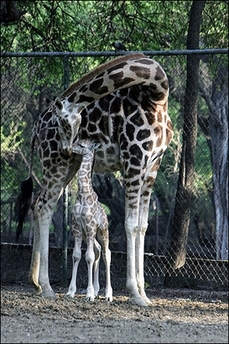African giraffes highly endangered - study
Updated: 2007-12-24 07:36
NAIROBI - Man and mother nature are threatening at least six distinct species of African giraffe, which are highly endangered and could face extinction if not protected, a study warned Saturday.
 A new born male African giraffe plays with his mother at the Delhi Zoo in India in March 2007. Man and mother nature are threatening at least six distinct species of African giraffe, which are highly endangered and could face extinction if not protected, a study warned Saturday. [Agencies] |
Africa's 110,000-strong giraffe population, initially thought to be comprised of a single species found in all its savannas, has been severely fragmented by increasing aridity and a wide range of human pressures, Kenyan and US biologists said in a study.
"Severe poaching and armed conflict in Somalia, Ethiopia, and Kenya reduced the number of reticulated giraffes from about 27,000 individuals in the 1990s to currently fewer than 3,000 individuals," over the past decade, said the study supported by the US-based Wildlife Conservation Society.
"Several of these previously unrecognized genetic units are highly endangered, such as the West African giraffe, numbering about only 100 individuals and restricted to a single area in Niger," it added.
At least 160 Nigerian giraffe (Giraffa camelopardalis peralta) are found in West and Central Africa while a few hundred Rothschild giraffe (Giraffa camelopardalis rothschildi) are found in protected areas in Kenya and Uganda.
The researchers said the extinction threat was real since giraffes are listed as lower risk in the World Conservation Union (IUCN) Red List, "under the assumption that giraffe species are considered a single species and therefore managed as such."
Published in the latest issue of the BMC Biology journal, the study of the animals' genetic makeup contradicted the single-species theory.
Failure by the wildlife community to recognise this "could lead to further endangerment or even extinction" of giraffes, it warned, calling for conserving and separately managing the different giraffe populations.
The giraffe study, which comes as the International Giraffe Working Group (IGWG) is reviewing the giraffe status, is only the latest alarm to be raised over Africa's dwindling wildlife population.
The IGWG is currently working with several wildlife authorities in Africa to carry out a census on giraffe, which grow up to 20 feet (six metres) in height and adults weight between 1,000 and 2000 kilogrammes (2,200-4,400 lbs).
The exercise is currently underway in southern Sudan, home to the recently discovered four distinct giraffe species that survived more than two decades of civil war.
They found two extremely distinct species -- reticulated giraffe (Giraffa camelopardalis reticulate) in northern Kenya and the Maasai giraffe (Giraffa camelopardalis tippelskirchi) in southern Kenya -- living close to each other, yet they were genetically separated between 0.5 to 1.5 million years ago.
These geographical variations in trains, such as fur and spot pattern (pelage) evident in the mammal's range in sub-Saharan Africa, was caused by reproductive isolation (selective sex) among species and habitat differences like vegetation at a micro-level, they said.
The finding, they said, strongly supported their position that mammals had different species.
In September, wildlife experts warned that "dysfunctional" African parks were losing species, particularly large mammals, due to poor conservation and pressure on resources.
Human activities -- spurred by rapid population growth and a quest for higher standards of living -- have also undermined the efforts of African governments and conservationists to protect animals, they said.
|
|
|
||
|
||
|
|
|
|